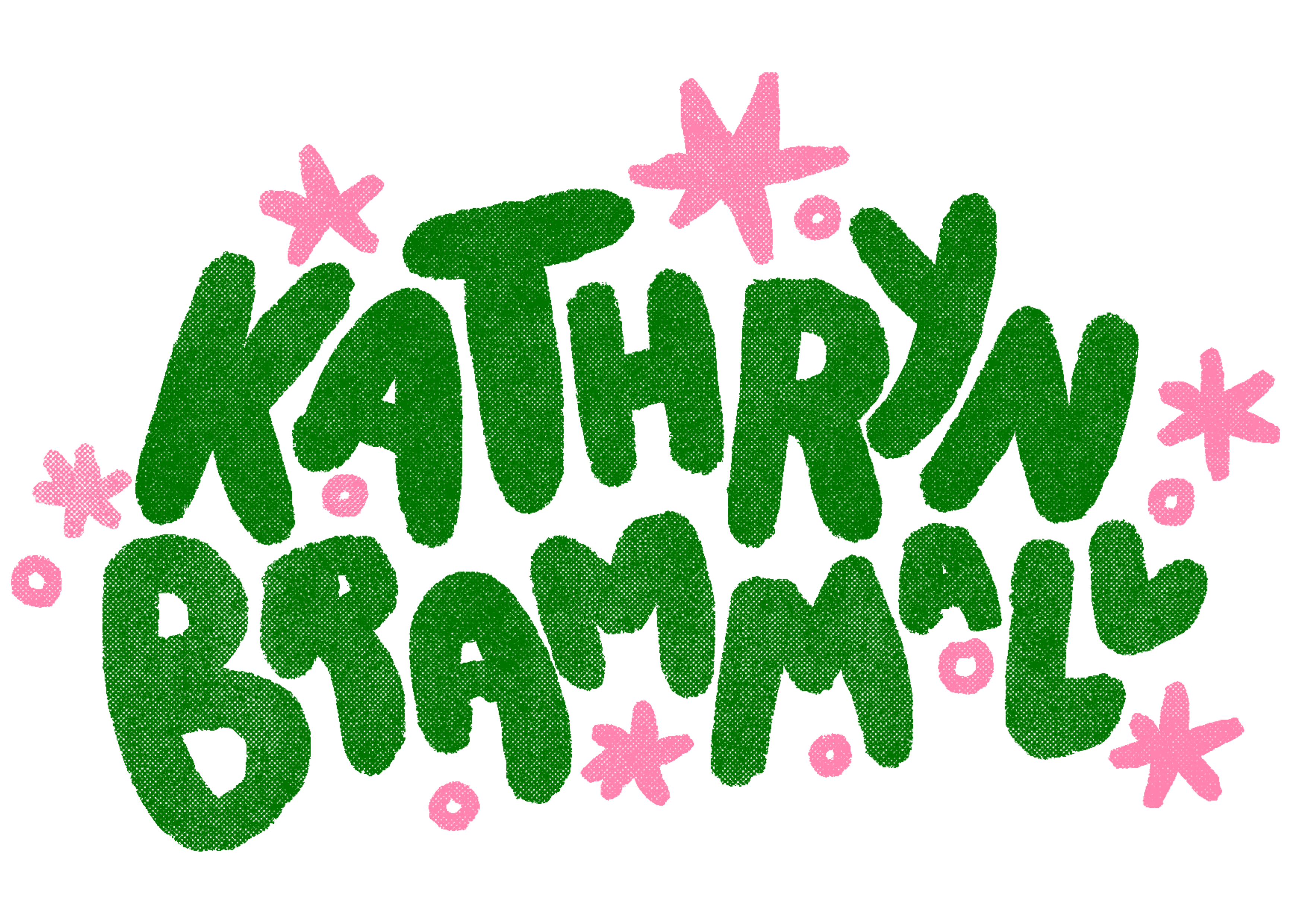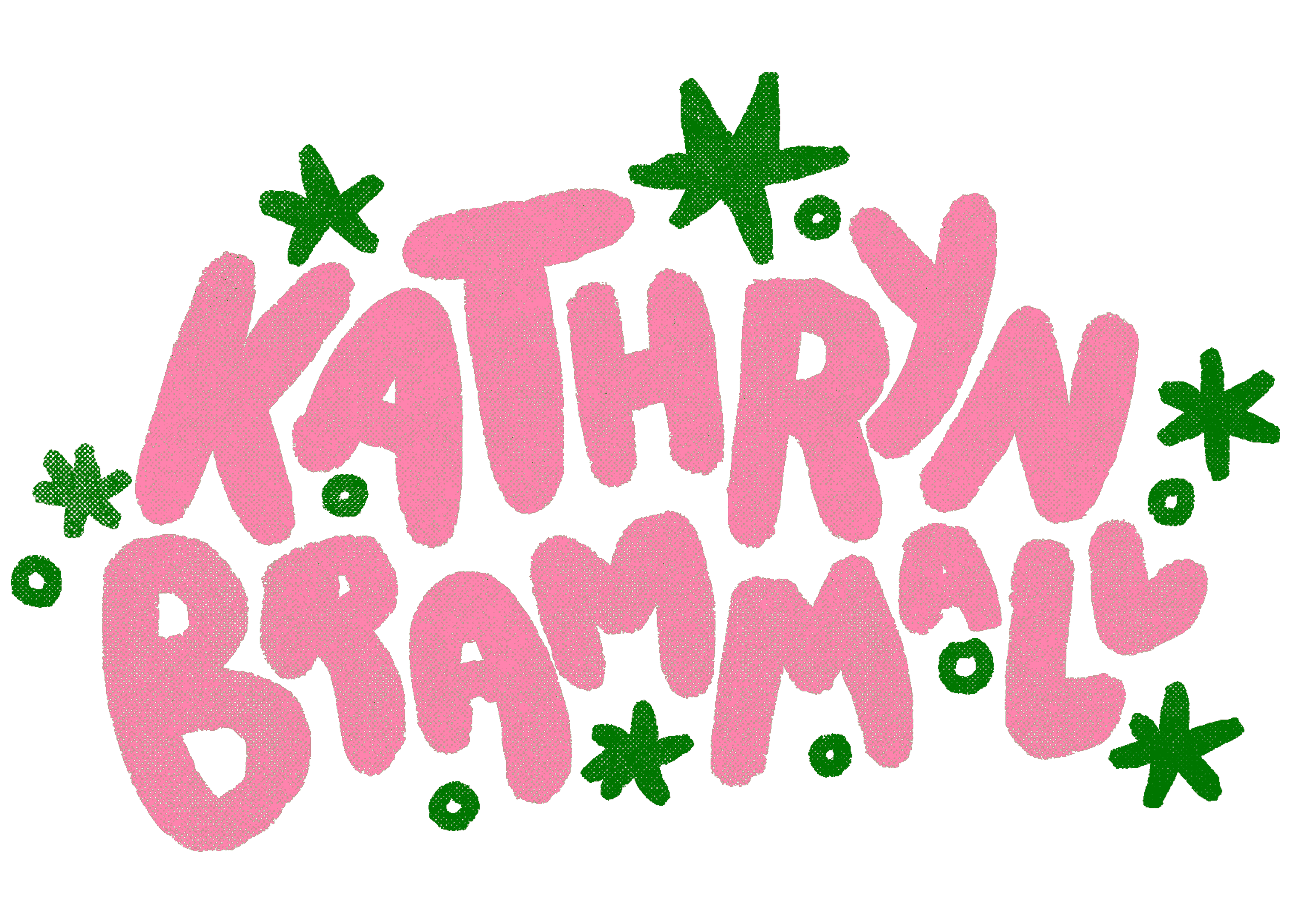'Child' by Kathryn Brammall, as featured in
'Softcore' - a book by Rebecca Orr
To be viewed accompanied by the album ‘Four Postcards’ by Hiroshi Yoshimura.
My childhood was filled with games. Different devices I was lucky enough to play on, different games I was lucky enough to play. It felt like a little bubble that I shared with my siblings, watching them play games I wasn’t good at, or was too young to play.
‘Child’ is a representation of the comfort games have brought me, and the continuous connection it has with my family. This is combined with colours I rejected as a young girl, instead strictly adhering to the unspoken colour code of the tomboy. I embrace these colours now in almost every piece of work I make, and shockingly it doesn’t stop me from liking video games.
Interview:
Rebecca Orr is joined in conversation with Kathryn Brammall, an illustrator, artist and arts tutor who loves making playful, goofy art that is exceedingly colourful. She is passionate about creating art in a joyful way, and aims to create work that shares joy with the viewer. She is based in Surrey, UK.
✸
RO: Hi Kathryn, how would you describe your practice overall?
KB: I approach my practice in a joy centred way. I want to make work that makes me happy and that I enjoy making, which sounds obvious, but I really want to stay away from the tortured artist concept. Creating things is a marvellous, wonderful thing and I am very lucky to be able to do it as often as I do. I feel like cute and playful work can be overlooked and get dismissed as being silly, but silliness and playfulness are crucial in life, at least in my opinion. This doesn’t mean that seemingly light-hearted and joyful work can’t have a deeper meaning because it absolutely can, but my practice rarely starts with a specific meaning.
RO: And do you have any key themes you work around?
KB: I often focus on media and topics that are interesting me at the time, as well as shapes and colours I am particularly drawn to. I love to embrace goofy things, whilst presenting them within almost a fine art context. My series of ‘BUTTZ’ is also a monthly serial reflection of my life in a very purely silly way, which is super fun to indulge in every month. I have also produced a lot of work about mountains and climbing, which due to my lack of access over the pandemic has taken a bit of a step back from being the centre of my work focus.
RO: By focusing on a variety of topics that interest you, do you think this allows your work a sense of fluidity? Do you enjoy this?
KB: Oh absolutely, and I think this is one of the key components that keeps me going as an artist. The fluidity means I don’t feel stuck with one particular idea, which is something I used to really struggle with. I loved defining myself by something very specific and niche, like being really into cowboy culture or rock climbing and mountains, but now I want to expand that and just accept both myself and my work for what it is and what it wants to be.
I still love climbing and cowboy culture deeply and will continue to make work about it, but by embracing change it allows me to feel as creatively free as possible, while remaining visually consistent. Even going back to my early work from 2017, I can still see really core elements that I still use like certain colours and shapes, but the ideas and development have evolved and grown over time.
It can be stressful at times, particularly when I feel like I am leaving something behind, especially when it was such a recognisable trait like my cowboy hats. But part of my development as an artist has been recognising that those things can still be there, whilst realising they don’t have to completely define me.
RO: I agree that ‘playful’ and ‘cute’ work can often get overlooked or dismissed - have you experienced any barriers around this? Do you think there is still a sense of hierarchy prevalent within the art world that causes these barriers?
KB: I haven’t experienced much on a directly personal level, especially since my work prior to the pandemic was much more ‘serious’ in tone so I wasn't seen as a ‘cute’ artist much at the time. However, I do absolutely believe there is a hierarchy in the art world that prioritises more apparently serious work, and I do worry that people won’t take me and my work seriously as it is so cute and playful. But to me this is also a barrier for them, as they are preventing themselves from enjoying fun artwork.
Cute art is often aligned with the feminine, and I believe that misogyny prevails in dismissing ‘cute’ artwork as a genuine art form. Playfulness is often encouraged in the fine art world, but once that playfulness starts to take on a cute tone, I feel that is when it starts to get overlooked. I used to reject feminine things out of fear of being overlooked for this exact reason, but through my work I want to repair my relationship with the feminine and embrace it fully.
RO: You mention that your practice rarely starts with a specific meaning; do your works end up taking on a specific meaning as you develop them, or do they remain without a specific meaning even after completion? In addition to this, do you find developing work that doesn’t have a specific meaning allows for the viewer to connect more/differently with the work as they can construct their own meaning/narrative for it?
KB: I feel my work can often take on its own meaning as it is developed, for example my repairing of the relationship to the feminine and nourishing the inner child, but just as many pieces remain on their own without specific meaning. I feel the meaning is what they are representing over time and how that reflects my state of mind at the time I was making them. My work frequently evolves and changes as I change, but there are always certain consistent elements that stay behind.
My work’s meaning also comes from its general atmosphere: joy, colour, celebration, love, playfulness, and fun. These are the remaining elements that I hope I always have in my life, and I think my work is one of the ways I keep these things with me as I grow.
I do absolutely agree that keeping my meaning relatively open allows my viewers to connect on their own and find their own meaning. I do hope that my work brings them joy, but beyond that I feel like they are able to connect their own feelings and experiences. My mountain work has an extremely specific vision in which I wanted to transport the viewer to the mountains, but my newer more playful work exists in this fun and silly world that I hope the viewer can bring themselves into.
RO: What are your motivations for wanting to work on a larger scale? Do you think working on a larger scale allows your work to feel more ‘alive’ and playful?
KB: Definitely. I miss making the giant paintings that I made during my degree, and I wish I could bring my current work to that size as I feel like it would really represent those ideas in their strongest form. It makes the idea feel much more tangible to me and can make a bigger impression on the viewer as it takes up considerable physical space. I like the idea of taking something so feminine and allowing it to take up space unapologetically.
There is also that element of creative freedom that comes with space, and because I have been solely working from my desk, I do frequently feel limited by it. But those limitations have brought out digital work I never knew I could make, so there have been huge benefits to this restriction. I hope now I can create both this new digital work and eventually in the future bring it into the large physical realm to realise it fully in my own vision.
RO: Any there any artists or artworks you feel most inspired by? Why?
KB: There are so many that I could name but I think particularly the artist Ed Cheverton inspires me, his work really embodies the playfulness that I love so much. The charming, lovable characters he makes with shapes and colours really embodies so much of what I love about illustration.
Also, the game designer Keita Takahashi and specifically his work on the game Katamari Damacy is one of the biggest inspirations for my current work. The incredible tiny worlds he creates within his games, as well as the extremely endearing set of characters known as Cousins in Katamari Damacy are so perfect in form to me. They contain so much whimsy and fun.
RO: Anything new you want to try?
KB: I would love to be able to make pottery, as well as make large scale papier-mâché work. Sculpture isn’t something I have explored much but it really interests me, and I would love to bring some of my drawings to life in that way.
Currently I am working within a small space and don’t have access to a studio, so larger work in general is something I am unable to make at the moment. I love making absolutely massive paintings too, so I hope I eventually get to return to that scale of work. For now, my digital experimentations continue to expand which is exciting as well, so I hope to learn more on that front too.
RO: Any wishes for the future?
KB: I am hoping to get back to travelling eventually as the pandemic has really restricted my movement, so I am hoping I can get back to my travel work and mountain drawings. It’s been a long time since I have done any rock climbing or skiing, so I look forward to reconnecting to that part of my work, as my focuses have shifted over a lot.
✸

